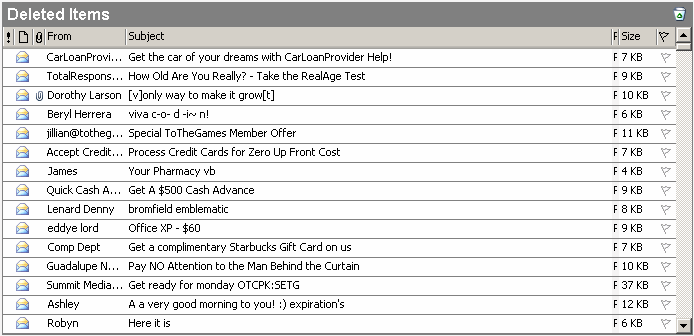
You’re probably used to getting plenty of junk mail delivered to your physical mailbox.
Fliers you don’t want, coupons you don’t need, and endless catalogs show up on a daily basis.
In the last thirty years or so, as the Internet and email have become more prominent, spammers have realized that it’s often cheaper and more effective to peddle their wares online.
Online spam is any unwanted or malicious communication that takes place on the Internet.
The newsletter you never signed up for? Spam. Fake social media accounts that send you links to adult websites? Spam. Comments on blogs that link to strange websites? Yep — those are spam.
Here’s our guide to identifying the different kinds of spam and how you can see less of it online.
The Different Types of Spam
If you see an unsolicited message in your private communications online, there’s a good chance it counts as spam.
Almost anything can be spam, but in order to fully understand the scope of the problem, it helps to break down the various mediums shady marketers and cybercriminals can use to bombard you with messages.
Comment Spam
If you own and operate your own blog, or even read them frequently, you’re undoubtedly familiar with comment spam.
When you see comments from users with strange usernames, often in broken English or even gibberish, promoting a link to their website, there’s a good chance you’re dealing with spammers.
The most common reason for comment spam? Website owners looking to gain an easy link back to their site, both for a bit of traffic and an SEO boost. But be careful — links left in comments on blogs might just trigger malware downloads.
Email Spam

Anyone who’s owned the same email address for more than a few years is likely inundated with unwanted advertising and scam messages every single day.
Most email providers have gotten better at filtering these messages out, but underhanded marketers and cybercriminals are usually on the cutting edge when it comes to bypassing those filters.
Email spam could be anything from an advertisement for a bizarre health supplement to those infamous pleas for financial help from a Siberian prince. Engaging with spam email could be completely harmless, or it could bring you in contact with Trojan horse malware and other malicious attacks.
Instant Message Spam
If you use any kind of instant messaging client, spammers may be able to target you there, as well.
It’s not hard for your email or username to fall into the wrong hands, even if you’re a pretty safe Internet browser. From there, adult websites, supplement companies, gambling platforms, and even hackers can send you whatever they want.
Not even Gchat users are completely safe from messaging spam.
Social Media Spam
It’s remarkably easy to set up a fake profile on Facebook, Instagram, and other social media platforms.
If you’ve ever received an out-of-the-blue friend request from a beautiful, scantily-clad woman you’ve never met, there’s a good chance you’re dealing with adult social media spam!
Similar to blog comment spam, social media spammers are usually looking to blast out links to their websites or products en masse and play the odds that they’ll get a few clicks. It’s extremely easy to do this quickly at a massive scale and for very little cost, so any web traffic or purchases gained will be pure profit.
Phishing Spam
Phishing spam deserves its own mention because of its massive consequences.
Cybercriminals and hackers can contact you on any online platform — and even over text message or on the phone — in order to attempt to steal your personal information.
Commonly, phishers will pretend to be a representative from your bank, credit card, utility company, or government in order to trick you into handing over sensitive information. From there, they can use that information to steal your identity.
Phishing most commonly occurs over email, but be extremely wary of live phone calls where someone demands to know your full account number, password, or credit card number.
What’s The Difference Between Spam and Advertising?
The line between spam messages that promote products and legitimate advertising has become extremely blurry.
Is that email from Amazon spam, or an ad? Is a pop-up ad spam?
In a sense, the term is subjective. If you don’t want to see it, it’s spam to you!
However, there are a few key points to keep in mind that differentiate the two:
Solicited vs. Unsolicited
When you get an email from a company you’ve never heard of, trying to get you to buy their male enhancement drug, that’s spam. You never engaged with the brand, they simply got your email from a third party and started blasting out messages.
If you create an account on Target’s website and make a purchase, however, you might expect to see advertising in your inbox (and real mailbox) from time to time. You voluntarily handed over your information and likely agreed to their terms spelled out in the fine print.
That’s not spam, that’s email marketing.
Can You Unsubscribe?

A key differentiator between legitimate advertising and spam is whether you can opt out.
You may have signed up for those Target emails, but it’s your prerogative to stop receiving them any time you want. Any message from a respectable business should offer you an easy way to opt out, unsubscribe, or otherwise stop receiving messages.
You likely won’t get that option from more malicious senders.
Manipulative or Dishonest Marketing
Simply put, spam messages usually make outrageous claims or otherwise try to trick you into handing over your attention or money.
Get free cash now! Spend the night with beautiful singles in your area! This supplement cures cancer!
Spam messages might also feature links that redirect you to a different URL once you click them, making it hard to know exactly where you’re headed.
If a legitimate company couldn’t stand behind the claims and practices in an online message, there’s a good bet it’s spam.
Is Spam Illegal?
Online advertising, even aggressive forms of it, are not illegal. Though they certainly can be annoying!
However, there are a few triggers that tip the scales toward making spam illegal:
No Opt Out
According to CAN-SPAM requirements, users must be able to opt out of unsolicited advertising.
If an advertising email or other message is missing details on how you can unsubscribe, it might be breaking the law.
Aliases and No or Fake Contact Info
When it’s not clear who or where messages are coming from — either they include an alias or don’t offer any sort of address or other contact information — they’re in violation of spam laws.
Automated Harvesting of Email Addresses
There are plenty of legitimate firms out there that sell leads to businesses in order to help them advertise.
However, it’s illegal for a company to use automated means of scraping various parts of the Internet for contact information.
3 Tips for Preventing Spam
It’s really hard to completely avoid seeing any spam online.
However, there are a few things you can do to prevent it and minimize the aggravation it might cause you.
Be Protective of Your Email Address
Cybercriminals like to scrape all corners of the web to gather as many email addresses as they can. It’s illegal, but they do it anyway — that’s what makes them criminals!
Keep yours hidden whenever possible. Don’t post it publicly unless it’s absolutely necessary. If you do need to post your email address or other online contact information, try to conceal it.
For example, instead of typing “yourname@gmail.com” you might type “YOURNAME AT GMAIL DOT COM,” so only humans can understand your intent.
Use a Reputable Antivirus
A good antivirus program can’t completely block any spam from entering your inbox, Gchat, or social media, but it can protect you from the worst of them.
The best antiviruses on the market will include protection from phishing, ransomware, and other extremely malicious attacks. That way, if spammers do trick you into downloading a Trojan or triggering a drive-by download, you’ll have extra protection in place.
Never Engage with Spam
If you do receive an unsolicited message online, it’s best to leave it alone completely.
Delete it and report it as spam to your email provider, if possible.
Replying or clicking any links in the message may put you at serious risk for malware attacks, identity theft, and more.
Online spam is relentlessly annoying, at best, and extremely dangerous at worst. Along with putting basic protections in place like the suggestions above, you’d be wise to learn to mentally filter it out.
Don’t engage with it, don’t click on it, don’t even look at it!
Without eyeballs and attention, professional spammers have no incentive to continue their aggravating work.